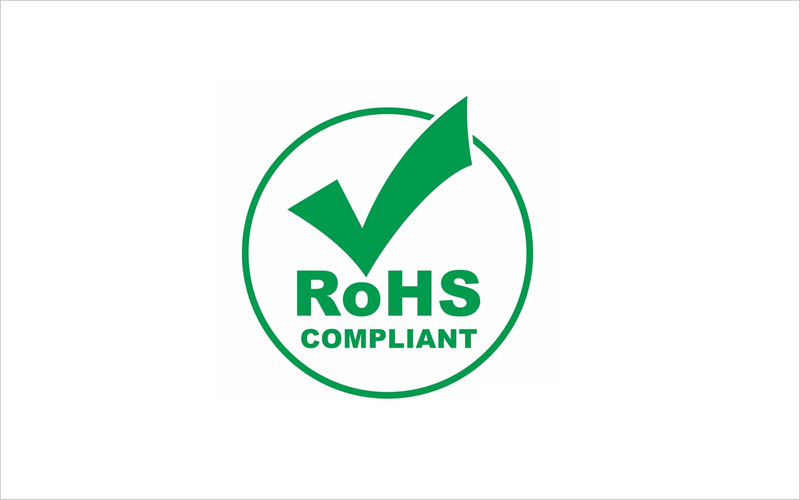
European Union RoHS, the "Directive on the Restriction of the Use of Certain Hazardous Substances in Electrical Electronic Equipment", refers to the reduction of environmental health risks caused by hazardous substances in electrical electronic equipment (EEE). The original directive 2002/95/EC was implemented on July 1, 2006, covering eight categories of electrical electronic equipment (EEE) with direct current under 1500V alternating current under 1000V. ) The content of lead (Pb), mercury (Hg), hexavalent chromium (Cr(VI)), polybrominated biphenyls (PBBs) polybrominated diphenyl ethers (PBDEs) shall not exceed 1000ppm, the content of cadmium (Cd) shall not exceed 100ppm.
RoHS 2.0 (2011/65/EU) took effect on July 21, 2011, was ally implemented on January 3, 2013 (2002/95/EC was abolished on the same day).

Important changes in RoHS2.0
Incorporated into the requirements of the CE marking, becoming one of the EU CE marking directives. In addition to the above-mentioned electrical electronic products must comply with (LVD), electromagnetic compatibility (EMC), energy-related products (ErP) RoHS2.0 directive requirements, in order to paste the CE mark , In addition to issuing a declaration of conity, RoHS2.0 also requires manufacturers to issue supporting technical documents, which will be retained for ten years.
Exp the scope of management control products, adding category 8 medical equipment category 9 monitoring equipment, adding category 11 other electrical electronic equipment. In order to allow manufacturers newly incorporated into ROHS 2.0 controlled products to have sufficient time to comply with the requirements of the directive, ROHS 2.0 has set a transition period for related products.
Preferentially select 4 toxic hazardous substances (HBCDD, DEHP, DBP BBP) as cidates for restricted substances, which may be included in control in the future.
HBCDD hexabromocyclododecane 1000ppm
DEHP phthalic acid (2-ethylhexyl) ester 1000ppm
DBP dibutyl phthalate 1000ppm
BBP butyl benzyl phthalate 1000ppm
The new version of the EU RoHS Directive 2011/65/EU was issued on July 1, 2011. At present, the original six items (lead Pb, cadmium Cd, mercury Hg, hexavalent chromium CrVI, polybrominated biphenyls PBB, polybrominated diphenyl ethers PBDE) are still maintained; the four previously mentioned in the industry (HBCDD, DEHP, DBP BBP) are not added, but priority Evaluation.
As a directive that Chinese electrical electronic product manufacturers are very familiar with, its promulgation process can be described as twists turns. Due to the large differences between the parties in the revision process, this amendment, which was originally intended to be introduced in 2009, has been ayed. In particular, there have been fierce debates within the EU, including the Commission, the European Parliament, the Council, the industry, NGOs, on whether to exp the scope of products restricted substances.
The main differences between 2011/65/EU the original RoHS directive are:
1. Expansion of the product range: Medical equipment monitoring equipment are included in the scope of management control, the eleventh category of products not included in the previous top ten electronic electrical equipment has been added. Covers all electrical electronic products within the scope of the directive (including cables spare parts), stipulates certain requirements for category 8 medical devices category 9 monitoring control instruments (including industrial monitoring instruments) During the transitional period, in addition, 20 exemptions were given for these two types of products (listed in Annex IV);
Exped schedule for the application of electrical electronic product regulations:
– July 22, 2014 Medical equipment monitoring equipment
– July 22, 2016 in vitro diagnostic medical equipment
– July 22, 2017 Industrial monitoring equipment
– On July 22, 2019, the electrical electronic equipment not listed on it the scope of the previous RoHS directive
2. The scope of controlled substances has not been exped, the original limit requirements of the original six substances have been maintained. However, it is proposed that in the future review process, substances including DEHP, etc., should be reviewed first as a directive Pave the way for exping the scope of controlled substances in the future;
3. There are clearer definitions for manufacturers, importers distributors, their responsibilities are further regulated. In addition, manufacturers importers must continue to register EEE products that do not meet the requirements of the directive recall, pass relevant ination to distributors. An authorized representative can be appointed to per the duties related to CE marking RoHS directives on behalf of manufacturers outside the EU.
4. It stipulates that the products need to be affixed with the CE mark CE mark related matters: before the EEE product is put on the market, the manufacturer/importer/distributor must ensure that the The conity assessment procedure has carried out relevant assessments, the CE mark must be affixed to the final product. The relevant technical documents EU declaration of conity shall be retained for at least 10 years.
This directive will take effect on the 20th day of its issuance on OJ, member states need to trans it into national law before January 2, 2013, that is, the new directive will be ally implemented on January 3, 2013, the old directive 2002 /95/EC shall be repealed at the same time.
The release of 2011/65/EU will have a certain impact on China’s electrical electronic product manufacturing enterprises, especially since medical device products, monitoring control equipment products are included in the scope of regulation, so these two The impact of such manufacturing enterprises will be very huge; in addition, since the CE mark needs to be affixed to electrical electronic products, it will also be a huge challenge for the industry to comply with the requirements of the directive.